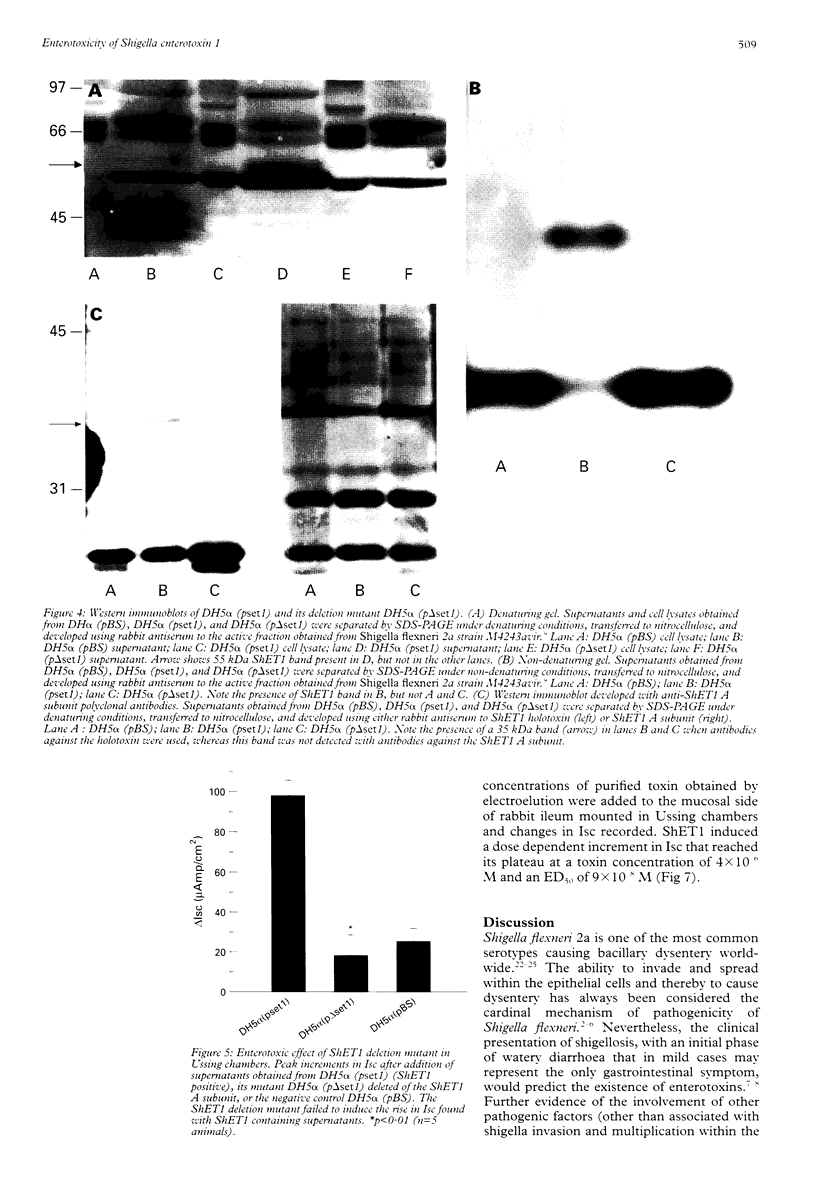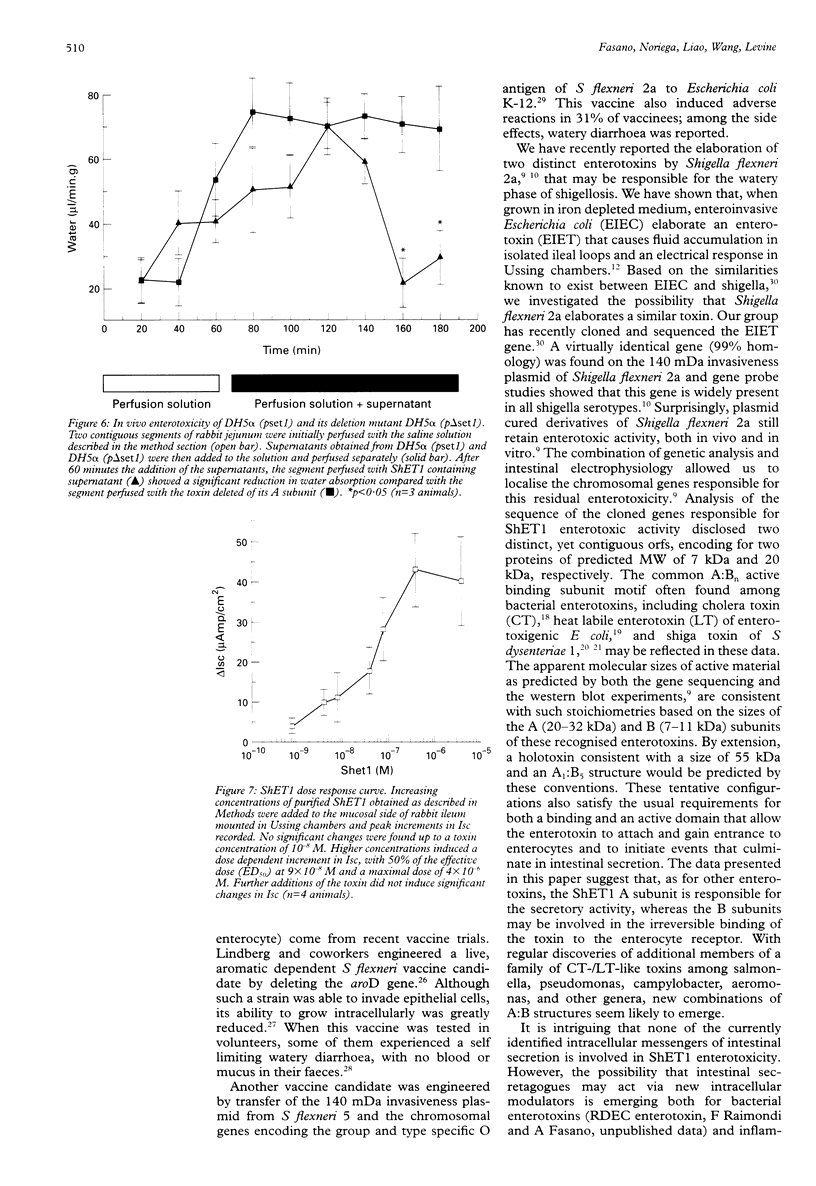Abstract
BACKGROUND: Shigella enterotoxin 1 is a novel enterotoxin elaborated by Shigella flexneri 2a that causes fluid accumulation in rabbit ileal loops and a rise in short circuit current in Ussing chambers. AIMS: To gain insights into the mechanism of action of shigella enterotoxin 1. METHODS: Supernatants from genetically engineered clones either overexpressing shigella enterotoxin 1 or producing deletion mutants of the toxin were tested in rabbit ileum both in vitro and in vivo. RESULTS: In rabbit ileum shigella enterotoxin 1 induced an irreversible rise in short circuit current that was not mediated by any of the recognised intracellular mediators of secretion. Deletion of 90% of the A subunit of the holotoxin ablated its enterotoxicity. In the in vivo perfusion model, the toxin induced a time dependent decrease in water absorption, whereas no changes were detected in the segment perfused with supernatants obtained from the deletion mutant. Finally, partially purified toxin induced a dose dependent increment in short circuit current that reached its plateau at a toxin concentration of 4 x 10(-6) M. CONCLUSIONS: Shigella enterotoxin 1 induces a time and dose dependent intestinal secretion in the rabbit animal model, suggesting that it may be responsible for the watery phase of Shigella flexneri 2a infection.
Full text
PDF






Images in this article
Selected References
These references are in PubMed. This may not be the complete list of references from this article.
- Barrett K. E., Cohn J. A., Huott P. A., Wasserman S. I., Dharmsathaphorn K. Immune-related intestinal chloride secretion. II. Effect of adenosine on T84 cell line. Am J Physiol. 1990 May;258(5 Pt 1):C902–C912. doi: 10.1152/ajpcell.1990.258.5.C902. [DOI] [PubMed] [Google Scholar]
- Bradford M. M. A rapid and sensitive method for the quantitation of microgram quantities of protein utilizing the principle of protein-dye binding. Anal Biochem. 1976 May 7;72:248–254. doi: 10.1016/0003-2697(76)90527-3. [DOI] [PubMed] [Google Scholar]
- Casalino M., Yusuf M. W., Nicoletti M., Bazzicalupo P., Coppo A., Colonna B., Cappelli C., Bianchini C., Falbo V., Ahmed H. J. A two-year study of enteric infections associated with diarrhoeal diseases in children in urban Somalia. Trans R Soc Trop Med Hyg. 1988;82(4):637–641. doi: 10.1016/0035-9203(88)90542-1. [DOI] [PubMed] [Google Scholar]
- Clements J. D., Flint D. C., Klipstein F. A. Immunological and physicochemical characterization of heat-labile enterotoxins isolated from two strains of Escherichia coli. Infect Immun. 1982 Nov;38(2):806–809. doi: 10.1128/iai.38.2.806-809.1982. [DOI] [PMC free article] [PubMed] [Google Scholar]
- Fasano A., Hokama Y., Russell R., Morris J. G., Jr Diarrhea in ciguatera fish poisoning: preliminary evaluation of pathophysiological mechanisms. Gastroenterology. 1991 Feb;100(2):471–476. doi: 10.1016/0016-5085(91)90218-a. [DOI] [PubMed] [Google Scholar]
- Fasano A., Kay B. A., Russell R. G., Maneval D. R., Jr, Levin M. M. Enterotoxin and cytotoxin production by enteroinvasive Escherichia coli. Infect Immun. 1990 Nov;58(11):3717–3723. doi: 10.1128/iai.58.11.3717-3723.1990. [DOI] [PMC free article] [PubMed] [Google Scholar]
- Fasano A., Noriega F. R., Maneval D. R., Jr, Chanasongcram S., Russell R., Guandalini S., Levine M. M. Shigella enterotoxin 1: an enterotoxin of Shigella flexneri 2a active in rabbit small intestine in vivo and in vitro. J Clin Invest. 1995 Jun;95(6):2853–2861. doi: 10.1172/JCI117991. [DOI] [PMC free article] [PubMed] [Google Scholar]
- Ferreccio C., Prado V., Ojeda A., Cayyazo M., Abrego P., Guers L., Levine M. M. Epidemiologic patterns of acute diarrhea and endemic Shigella infections in children in a poor periurban setting in Santiago, Chile. Am J Epidemiol. 1991 Sep 15;134(6):614–627. doi: 10.1093/oxfordjournals.aje.a116134. [DOI] [PubMed] [Google Scholar]
- Hale T. L., Sansonetti P. J., Schad P. A., Austin S., Formal S. B. Characterization of virulence plasmids and plasmid-associated outer membrane proteins in Shigella flexneri, Shigella sonnei, and Escherichia coli. Infect Immun. 1983 Apr;40(1):340–350. doi: 10.1128/iai.40.1.340-350.1983. [DOI] [PMC free article] [PubMed] [Google Scholar]
- Ko Y. H., Thomas P. J., Delannoy M. R., Pedersen P. L. The cystic fibrosis transmembrane conductance regulator. Overexpression, purification, and characterization of wild type and delta F508 mutant forms of the first nucleotide binding fold in fusion with the maltose-binding protein. J Biol Chem. 1993 Nov 15;268(32):24330–24338. [PubMed] [Google Scholar]
- Kotloff K. L., Herrington D. A., Hale T. L., Newland J. W., Van De Verg L., Cogan J. P., Snoy P. J., Sadoff J. C., Formal S. B., Levine M. M. Safety, immunogenicity, and efficacy in monkeys and humans of invasive Escherichia coli K-12 hybrid vaccine candidates expressing Shigella flexneri 2a somatic antigen. Infect Immun. 1992 Jun;60(6):2218–2224. doi: 10.1128/iai.60.6.2218-2224.1992. [DOI] [PMC free article] [PubMed] [Google Scholar]
- Kärnell A., Li A., Zhao C. R., Karlsson K., Nguyen B. M., Lindberg A. A. Safety and immunogenicity study of the auxotrophic Shigella flexneri 2a vaccine SFL1070 with a deleted aroD gene in adult Swedish volunteers. Vaccine. 1995 Jan;13(1):88–99. doi: 10.1016/0264-410x(95)80017-8. [DOI] [PubMed] [Google Scholar]
- Kärnell A., Stocker B. A., Katakura S., Reinholt F. P., Lindberg A. A. Live oral auxotrophic Shigella flexneri SFL124 vaccine with a deleted aroD gene: characterization and monkey protection studies. Vaccine. 1992;10(6):389–394. doi: 10.1016/0264-410x(92)90069-v. [DOI] [PubMed] [Google Scholar]
- Levine M. M. Escherichia coli that cause diarrhea: enterotoxigenic, enteropathogenic, enteroinvasive, enterohemorrhagic, and enteroadherent. J Infect Dis. 1987 Mar;155(3):377–389. doi: 10.1093/infdis/155.3.377. [DOI] [PubMed] [Google Scholar]
- Levine M. M. Escherichia coli that cause diarrhea: enterotoxigenic, enteropathogenic, enteroinvasive, enterohemorrhagic, and enteroadherent. J Infect Dis. 1987 Mar;155(3):377–389. doi: 10.1093/infdis/155.3.377. [DOI] [PubMed] [Google Scholar]
- Lindberg A. A., Karnell A., Pál T., Sweiha H., Hultenby K., Stocker B. A. Construction of an auxotrophic Shigella flexneri strain for use as a live vaccine. Microb Pathog. 1990 Jun;8(6):433–440. doi: 10.1016/0882-4010(90)90030-t. [DOI] [PubMed] [Google Scholar]
- Lospalluto J. J., Finkelstein R. A. Chemical and physical properties of cholera exo-enterotoxin (choleragen) and its spontaneously formed toxoid (choleragenoid). Biochim Biophys Acta. 1972 Jan 26;257(1):158–166. doi: 10.1016/0005-2795(72)90265-6. [DOI] [PubMed] [Google Scholar]
- Makino S., Sasakawa C., Yoshikawa M. Genetic relatedness of the basic replicon of the virulence plasmid in shigellae and enteroinvasive Escherichia coli. Microb Pathog. 1988 Oct;5(4):267–274. doi: 10.1016/0882-4010(88)90099-x. [DOI] [PubMed] [Google Scholar]
- Nataro J. P., Seriwatana J., Fasano A., Maneval D. R., Guers L. D., Noriega F., Dubovsky F., Levine M. M., Morris J. G., Jr Identification and cloning of a novel plasmid-encoded enterotoxin of enteroinvasive Escherichia coli and Shigella strains. Infect Immun. 1995 Dec;63(12):4721–4728. doi: 10.1128/iai.63.12.4721-4728.1995. [DOI] [PMC free article] [PubMed] [Google Scholar]
- Noriega F. R., Liao F. M., Formal S. B., Fasano A., Levine M. M. Prevalence of Shigella enterotoxin 1 among Shigella clinical isolates of diverse serotypes. J Infect Dis. 1995 Nov;172(5):1408–1410. doi: 10.1093/infdis/172.5.1408. [DOI] [PubMed] [Google Scholar]
- Olsnes S., Reisbig R., Eiklid K. Subunit structure of Shigella cytotoxin. J Biol Chem. 1981 Aug 25;256(16):8732–8738. [PubMed] [Google Scholar]
- Piéchaud D., Szturm-Rubinsten S., D'Hauteville H., Fourquet R. Epidémiologie de la dysenterie bacillaire à Djibouti. Bull Soc Pathol Exot Filiales. 1971 Jan-Feb;64(1):37–42. [PubMed] [Google Scholar]
- Pál T., Formal S. B., Hale T. L. Characterization of virulence marker antigen of Shigella spp. and enteroinvasive Escherichia coli. J Clin Microbiol. 1989 Mar;27(3):561–563. doi: 10.1128/jcm.27.3.561-563.1989. [DOI] [PMC free article] [PubMed] [Google Scholar]
- Sansonetti P. J., Kopecko D. J., Formal S. B. Involvement of a plasmid in the invasive ability of Shigella flexneri. Infect Immun. 1982 Mar;35(3):852–860. doi: 10.1128/iai.35.3.852-860.1982. [DOI] [PMC free article] [PubMed] [Google Scholar]
- Seidah N. G., Donohue-Rolfe A., Lazure C., Auclair F., Keusch G. T., Chrétien M. Complete amino acid sequence of Shigella toxin B-chain. A novel polypeptide containing 69 amino acids and one disulfide bridge. J Biol Chem. 1986 Oct 25;261(30):13928–13931. [PubMed] [Google Scholar]
- Sladen G. E., Harries J. T. Studies on the effects of unconjugated dihydroxy bile salts on rat small intestinal function in vivo. Biochim Biophys Acta. 1972 Nov 2;288(2):443–456. doi: 10.1016/0005-2736(72)90265-9. [DOI] [PubMed] [Google Scholar]
- Sladen G. E., Harries J. T. Studies on the effects of unconjugated dihydroxy bile salts on rat small intestinal function in vivo. Biochim Biophys Acta. 1972 Nov 2;288(2):443–456. doi: 10.1016/0005-2736(72)90265-9. [DOI] [PubMed] [Google Scholar]
- Taylor D. N., Echeverria P., Pál T., Sethabutr O., Saiborisuth S., Sricharmorn S., Rowe B., Cross J. The role of Shigella spp., enteroinvasive Escherichia coli, and other enteropathogens as causes of childhood dysentery in Thailand. J Infect Dis. 1986 Jun;153(6):1132–1138. doi: 10.1093/infdis/153.6.1132. [DOI] [PubMed] [Google Scholar]
- Taylor D. N., Echeverria P., Sethabutr O., Pitarangsi C., Leksomboon U., Blacklow N. R., Rowe B., Gross R., Cross J. Clinical and microbiologic features of Shigella and enteroinvasive Escherichia coli infections detected by DNA hybridization. J Clin Microbiol. 1988 Jul;26(7):1362–1366. doi: 10.1128/jcm.26.7.1362-1366.1988. [DOI] [PMC free article] [PubMed] [Google Scholar]
- Venkatesan M. M., Buysse J. M., Kopecko D. J. Characterization of invasion plasmid antigen genes (ipaBCD) from Shigella flexneri. Proc Natl Acad Sci U S A. 1988 Dec;85(23):9317–9321. doi: 10.1073/pnas.85.23.9317. [DOI] [PMC free article] [PubMed] [Google Scholar]



